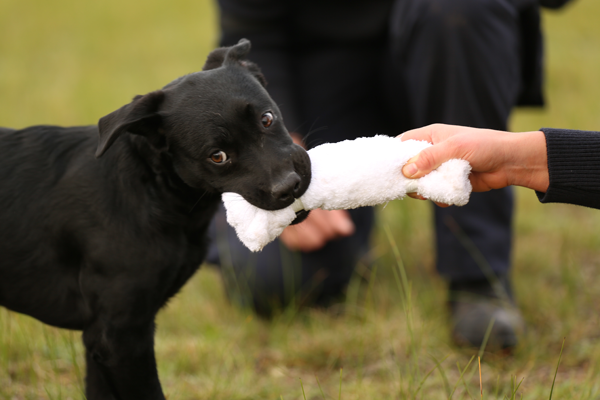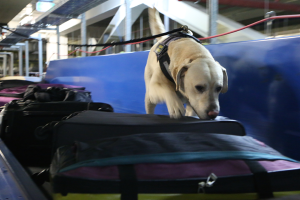Australian Border Force Detector Dog Program
18 June 2021
By the Australian Border ForceThe Australian Border Force (ABF) Detector Dog Program (DDP) is a national program divided into two sub-sections:
- Operations – responsible for seven regional operational units in Adelaide, Brisbane, Cairns, Darwin, Melbourne, Perth and Sydney.
- Breeding and training – responsible for the purpose breeding of detector dogs, and for the development and training of handlers and dogs to produce a high-quality detector dog team.
This article focuses on the latter, and more specifically on the work carried out at the National Detector Dog Program Facility (NDDPF), a purpose-built facility located near Melbourne Airport. This is where the ABF breeds detector dogs, and develops and trains detector dog teams before they are deployed. The NDDPF infrastructure caters for multiple training courses which are conducted by highly experienced, qualified and dedicated officers, as well as by DDP senior management. The teams service the needs of internal and external stakeholders – such as the Australian Federal Police – on both the domestic and international fronts.
Breeding
The ABF has been breeding dogs since 1993. It breeds Labrador Retrievers due to their high drive, steady temperament, adaptability to challenging environments, and non-threatening appearance. The DDP aim is to breed and raise a healthy colony of dogs, with a high percentage progressing to a working career. Animal health and welfare is the number one priority.
A yearly breeding plan is developed in accordance with demand, capacity, resourcing and funding. Challenges faced in developing the plan include selecting genetic pairs that eliminate, or limit, any adverse heritable traits, whilst equally focusing on suitable working dog qualities.
Compared to other private or public agencies managing similar dog programs, the ABF has encountered very few of the consistent health issues that usually hinder sustainable production. This is essentially due to the acquired knowledge and expertise of staff, which is continually enhanced through research, ongoing engagement with other dog programs and subject matter experts, and benchmarking to validate existing practices and processes.
The main limitations of the breeding program are related to resources and infrastructure. These include:
- Staffing and breeding stock numbers.
- Competencies of staff to deal with complex breeding activity.
- Having enough whelping and nursery areas to safely support activities.
DDP breeding and development officers, and animal attendants, attend the dogs during whelping and conduct pre- and post-whelping observations. The health and welfare of the mother and pups is paramount, and “whelp watch” is a 24-hour-a-day, 8-day operation which requires the reassignment of some staff in the facility over that period.
Foster carer program
The DDP is forecast to breed approximately 160 dogs this year. Managing that volume of dogs on site is not practical from a resource or infrastructure perspective. The ABF therefore fosters dogs out to community volunteers who form part of a network established back in 1993.
Dogs are placed with foster carers in the Melbourne community for around the first 12 months of their lives. This network currently numbers roughly 250 in total. Maintaining a suitable pool is not easy, and a lot of advertising and promotion is undertaken by the DDP.
The role of the foster carer is to socialize and enrich the dogs in their journey towards a working career. It is a lengthy and comprehensive process for a member of the public to become a foster carer. From the application stage, the process for approval takes about 10 weeks. This includes vetting of applications, site visits of their gardens or backyards to asses suitability, interviews, and assessment of their basic affinity for dogs. Each carer is provided with education sessions and access to a 24-hour support service, and receives advice throughout their journey. This investment pays off in the long run. The network is made up of people who are passionate and focused on doing everything they can to enhance the chances of success for their dog. Unfortunately, not all will become working dogs. Managing expectations, and the disappointments when dogs are deemed unsuitable, is an ongoing role. Countering that, the excitement when their fostered dog graduates, within the ABF or other agencies, is a highlight.
DDP development program
Prior to the foster carer receiving the dog, NDDPF staff undertake development and assessment activities. At three weeks of age puppies move to the nursery, where they are encouraged to explore and interact independently within their environment. They are placed with a foster carer at the age of nine weeks.
Puppies are regularly brought back into the facility for development activities and milestone assessments which focus on:
- Environmental stability – the dog’s confidence with its environment.
- General demeanour – the dog’s composure and ability to deal with stress.
- Performance – the dog’s drive to play and hunt, and its capacity to communicate that it has found the location of its target scent source or, in our jargon, perform an “indication”.
- Cognition – how the dogs learn.
The dogs undergo significant development throughout this phase to prepare them for training and life as a working dog. Unfortunately, not all make it to the next stage, but this is not for want of trying.

Training
The ABF has developed an excellent reputation for the quality of training that it delivers, and for the quality assurance process that guarantees the proficiency of all operational teams in the field.
Detector dog and handler training comprises three phases:
- A 12-week basic handler training course at the NDDPF.
- A four-month regional transition phase in the dog handler’s home port.
- A four-week final evaluation course at the NDDPF that delivers more advanced training and introduces the dog to additional target odours.
The primary objective is to promote independent search behaviour and detection decisions in all trained dogs. ABF training methodology is as follows:
- A combination of instrumental conditioning (dogs learn through actions resulting in rewards) and classic conditioning (dogs learn through association, they have an involuntary response to a stimulus).
- A focus on positive reinforcement; in other words, training uses a reward for desired behaviours.
- Use of a marker (that is a sound or a special word) to shape behaviour.
- Predominately off-source rewarding.
- Utilization of a variable reinforcement schedule (the behaviour is reinforced when a variable number of correct responses has occurred).
- Use of praise, food, towel and Kong, etc.
Training is highly technical and challenging; particularly given that novice handlers are trained alongside novice dogs. In total, each detector dog team undergoes approximately eight months of training before they graduate. As with dogs, not all handlers are suited to this role, so if standards are not met, handlers return to their original ABF work area.
This emphasizes the criticality of selecting the right person. This is a difficult procedure and the more rigorous the process, the greater the chances of getting it right. The ABF recruits handlers internally. The ideal candidate is results driven, has a broad understanding of the operating environment, and is a team player who can represent the organization professionally. An analytical mind with good problem-solving abilities helps keep a dog handler ahead of the game. A very good level of fitness is required to be able to work in a vast array of environments. In addition, an affinity with dogs is essential.
In accordance with DDP standards, handlers are required to maintain the health and well-being, and proficiency, of their dogs. Adherence to these standards is assessed as part of the annual DDP appraisal process that includes feedback reports and in-person assessment of handlers in their regional unit. The appraisal process is focused on sustained performance over a 12-month period. Formal feedback reports identify team strengths and weaknesses, while providing strategies for improved performance. This leads to a balanced view of a team’s sustained performance on an ongoing basis.
Deployment and operations
ABF detector dogs are deployed in all ABF operational areas to screen people, cargo, mail, vessels, aircraft and buildings. ABF detector dogs also support Federal, State and Territory police and other government agencies in search operations. Detector dogs have the ability to screen large volumes of people and goods quickly and efficiently. They provide an excellent complementary detection tool alongside technologies such as trace particle detection and x-ray.
The ABF has dogs that are able to detect narcotics, currency, firearms, explosives and tobacco. A number of these capabilities can be merged, but the ABF has siloed tobacco and explosives as stand-alone target odours. Narcotic detection remains the primary capability of most dogs and accounts for approximately 60% of all DDP operational tasks.
Use of the dogs for optimum performance requires ongoing education of “client user groups”, in other words those units that require the support of the dog handler team. The DDP regional units play an essential role in promoting the dog’s capabilities. Although officers within the program have a thorough understanding of what the dog can achieve, most others do not, which is completely understandable. Continual education on the following aspects is therefore essential:
- Detection capability – what the dogs can detect. Examples of detections can support the faith of the user group.
- How best to use the dog – e.g. how to design the search area to allow for optimum access to targeted articles, areas or people so as to give the dog the best chance of success.
- The support that is required prior to, during and after a deployment.

As stated above, the ABF operates seven regional units; together, these have a total of 76 detector dog teams currently deployed Australia-wide. Management of capability and resources is coordinated centrally at the NDDPF in consultation with the regional units. It focuses on ensuring that each region has the means to be able to respond in an agile and timely fashion to tasking requests from the ABF or partner agencies. These requests can result in a team having to travel thousands of kilometres with a minimal lead time. The handler must maintain the dog in an operational-ready state to best serve our clients’ needs.
The DDP is focussed on our bred dogs living a healthy and fulfilled life following their working career. Upon retirement the dog’s handler has first option to adopt them as a pet. Further options are for the dog’s foster carer or a suitable member of the public, who are vetted by our team to take them on.
Stakeholder engagement
Over the years, the Detector Dog Program has provided a range of different types of assistance to numerous domestic and international agencies and programs. This has included the provision of dogs, training and assistance in the implementation of breeding, training and operational units and the management of those functions. Key activities include:
- The provision of 150 dogs to other agencies in the last two years (despite decreased demand during the COVID pandemic).
- Development of a satellite foster carer program, partnering with the Australian Federal Police based in Canberra.
- Participation in the Fifth WCO Global Canine Forum, which the ABF hosted.
- Continuous delivery of technical support and assistance with regional capacity building together with international partners, although maintaining the balance of meeting requests with our current resources and infrastructure is challenging.
COVID-19 pandemic
As with all countries, Australia too suffered through tough times during the height of the COVID-19 pandemic, and this has had an impact on our DDP. Thankfully, Australia is now operating in a relatively ‘normal manner’ compared to some countries around the world. In saying that, Australia did endure some lengthy lockdowns, with the one in the State of Victoria, where our NDDPF is located, lasting 4 months. The DDP, and the NDDPF, had to adapt to the circumstances:
- Training courses were paused and rescheduled, and operated in bubbles avoiding personnel crossover.
- Breeding and development activity was paused.
- Operational taskings decreased significantly – dog health and enrichment became the focus for a period.
- Operational tasks were diverted to cargo and mail streams away from airports.
- Engagement with stakeholders, including the vast foster carer network, was conducted virtually.
- Staff worked from home where possible – this was not realistic for hands-on practitioners, so workplace bubbles were set up on a vast piece of land.
The DDP’s focus was to best prepare to re-emerge ready to meet demands when Australia returned to operating ‘normally’ again.
The ABF DDP has partnered with Adelaide University in a COVID dog detection feasibility research trial. Its support has included providing dogs, technical and operational staff, and funding. This trial is based on work conducted in a number of other countries worldwide. The initial clinical controlled phase of the trial has demonstrated that dogs can accurately discriminate between sweat samples taken from persons who have tested positive and negative to COVID‑19.
The next phase is to explore the lead researcher’s hypothesis that detector dogs can detect COVID via Volatile Organic Compounds (VOCs) during the active infectious period, but not VOCs after the active infectious period. Potentially, detector dogs may be able to provide a more accurate indication of whether a person is infectious than the standard Polymerase Chain Reaction (PCR) test that people take.
If the hypothesis is proven through further trials, there will be more evidence that dogs can be used to assist with the re-opening of Australian borders as part of a suite of control measures. Results of the next phase of trials are expected at the end of June 2021.
Summary
All dog programs face similar challenges with their established breeding, development and foster carer programs to those encountered by the ABF’s DDP. A consistent component of most programs is a team of skilled, dedicated and passionate staff. The chain of people, from the animal attendants through to the operational handlers, all play key and significant roles. Engagement with experts from partner agencies and programs, and our own contract veterinarian staff, is essential. All of this combined contributes to us breeding, developing, training and operating healthy and successful detector dogs.
More information
ddps@abf.gov.au

